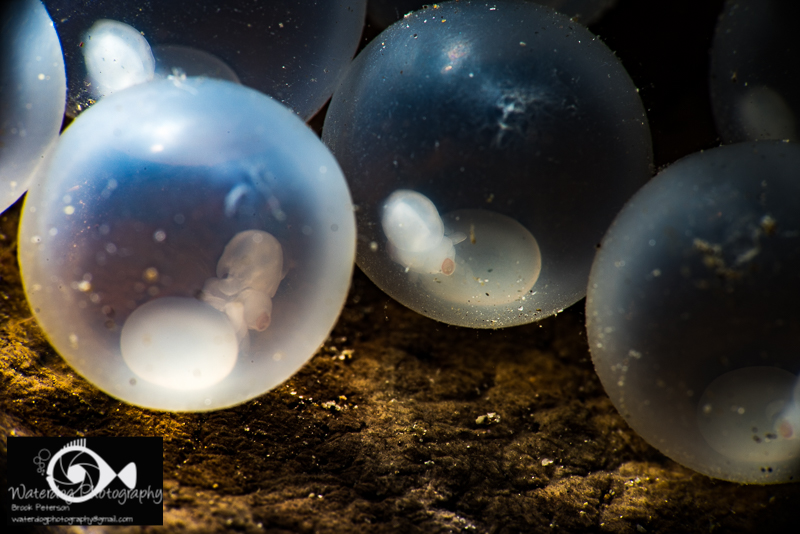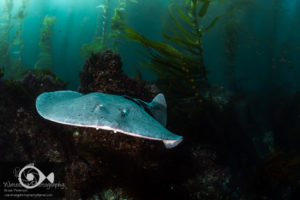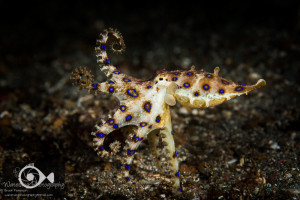I have always had a fascination with the development of new life, especially the embryo stage. As a child, I had an egg incubator that I tried (and failed) to incubate quail and chicken eggs in. I find the desire to see life beginning inside an egg is still persistent in my psyche, so it is exciting to find marine animals with eggs.
One of my favorite finds this year was a half coconut shell that had several dozen cuttlefish eggs inside. I was able to see through the egg to the developing embryo within. These embryos still have a week or more to go before they will hatch. The egg is about a half an inch in diameter, or about the size of a marble. These guys have a pretty roomy house!

Flamboyant Cuttlefish Eggs
Many marine animals carry their eggs with them. The male banded pipefish carries the eggs on the outside of his belly. These eggs are very close to hatching, and some have already hatched. You can see their eyes and tails in the closeup image.

Banded pipefish with eggs

Banded Pipefish eggs close up
Some fish are mouth breeders, and incubate the eggs in their mouth. The cardinal fish is a good example of this, and it is the male who carries the eggs. If you observe the fish for a while, you will see him roll the eggs around in his mouth to aerate them, sometimes nearly spitting them out.

Cardinal Fish with Eggs
Crabs also carry their eggs with them inside their carapace.

Crab with eggs

Porcelain crab with eggs

Hard coral crab with eggs
Isopods, such as skeleton shrimp carry eggs inside a membrane along their belly. Again, it is the male that carries the eggs. The fascinating thing about these babies is that after they hatch, they crawl all over their dad and stay on his body until they are half grown. The image below is of a newly hatched litter. They are clustered tight around the abdomen of the parent, and you can just barely see a few heads peeking up above the crowd.

Newly hatched skeleton shrimp
These young ones have been growing for a few days and have ventured out onto all their parent’s appendages.

Skeleton Shrimp with babies
Nudibranch eggs are laid in a beautiful spiral or ribbon. Some nudibranchs eat the eggs of other nudibranchs, and that is what is happening in the image below.

Nudibranch feeding on another nudi’s eggs.
Anemone fish care for their eggs in a nest near the anemone they live on, just like in the movie, “Finding Nemo.” It is the male that takes the most responsibility and he will aerate the eggs with his fins, and blow on them with his mouth. Sometimes, he will test the integrity of each egg by gently pressing it with his mouth.

Anemone Fish caring for eggs
This little critter is some kind of mantis shrimp, although a very tiny one. We found it laying on the sand with its eggs before it.

mantis shrimp with eggs
Some animals lay their eggs inside an egg case, like, lots of eggs within an egg shell. These eggs were deposited by a large brown cowrie (a type of snail) and are freshly laid.

Cowrie Eggs
As the eggs develop, they turn darker. The egg case eventually breaks down, and the newly hatched cowries float off into the water column until they settle on the substrate.

Well Developed Cowrie Eggs
It is amazing how diverse the egg universe is, and equally amazing how parents do or do not care for their young. Personally, I think it would be cool to be a skeleton shrimp and crawl all over my parent until my teenage years.
Please subscribe below! I promise that I will protect your privacy and I will never sell or share your e-mail.
[email-subscribers namefield=”NO” desc=”” group=”Public”]As always, if you enjoy my images please visit my website,waterdogphotography.com, or give me a like on facebook at Waterdog Photography Brook Peterson. Don’t forget to follow me here at waterdogphotographyblog and please feel free to share on Facebook or other social media.





